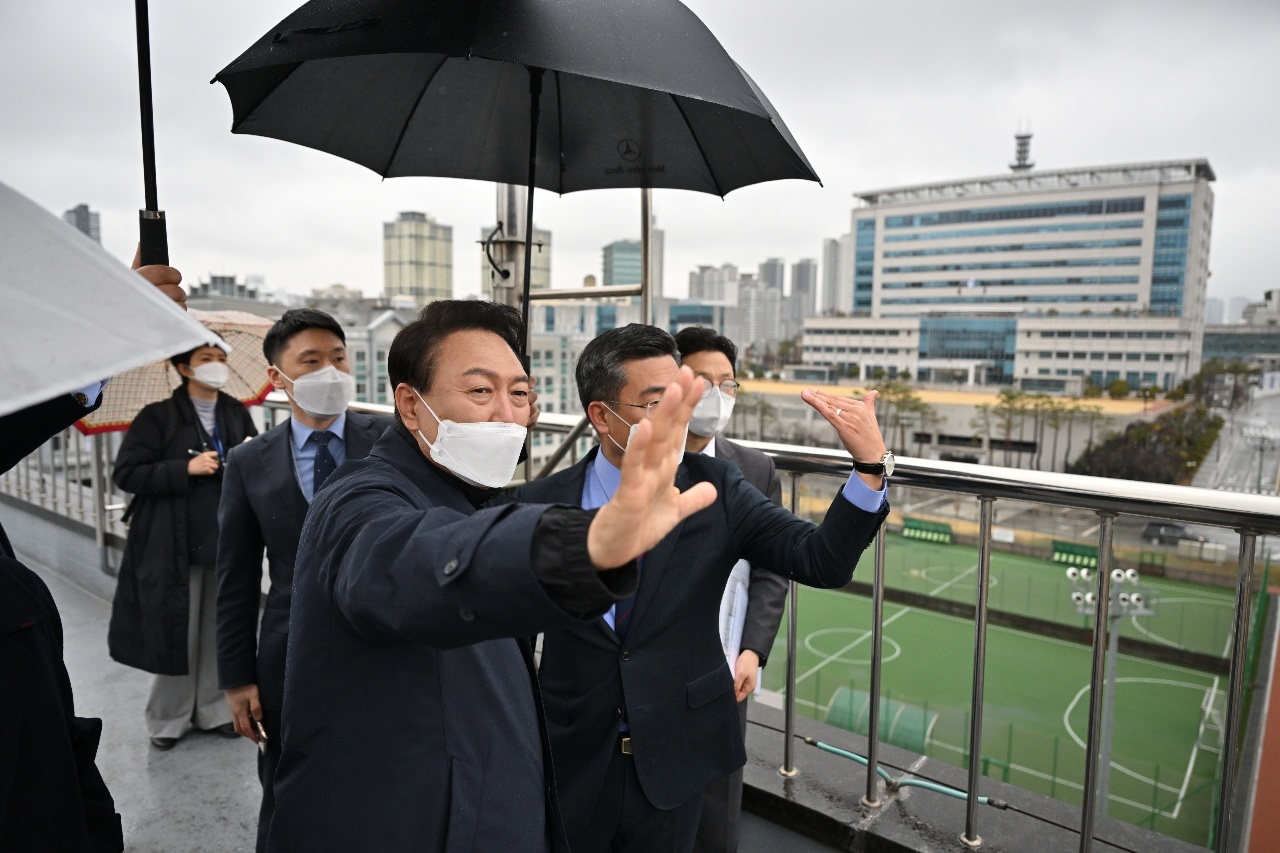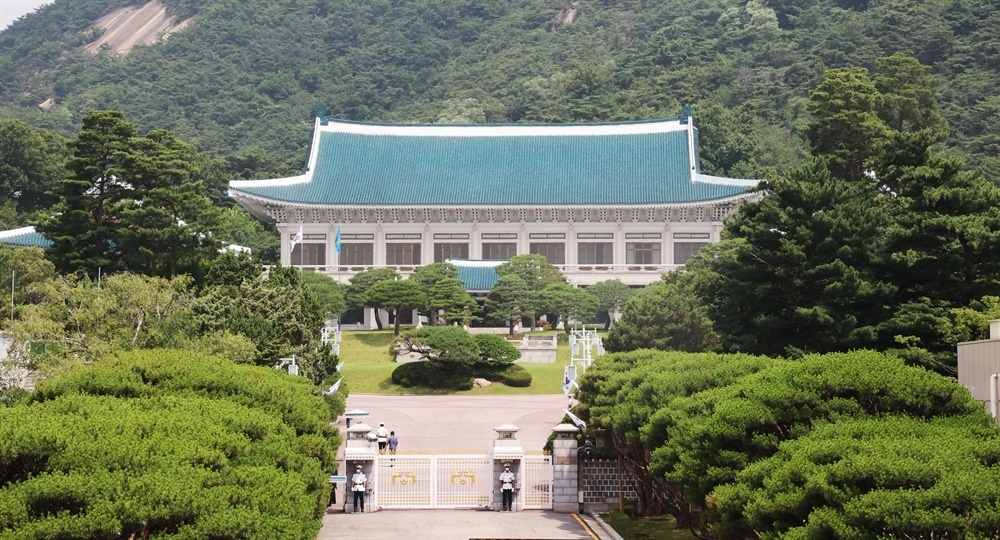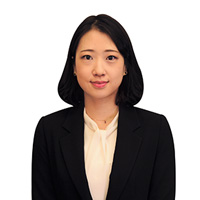Mixed reactions to Yoon’s relocation of presidential office
Residents of affected areas try to gauge impact on real estate prices, traffic, commercial districts
By Choi Jae-heePublished : March 20, 2022 - 15:56

South Koreans were largely divided over President-elect Yoon Suk-yeol’s announcement on Sunday of plans to move the presidential office to the Defense Ministry compound in Yongsan-gu, Seoul.
While some Yongsan residents expressed worry over downside risks to the region’s property market due to security-related restrictions, those living in neighborhoods near the current presidential office of Cheong Wa Dae in Jongno-gu, central Seoul, hoped it would open new development opportunities.
Kim Min-taek, 42, who has lived for almost a decade near Samgakji Station, about 500 meters north of the Defense Ministry compound, for almost a decade, feared the relocation of the top security facilities would mean “stricter building regulations” for ordinary homeowners.
“If the relocation materializes, the new government would likely toughen rules on nearby apartments and buildings that are old and subject to redevelopment projects, like the floor area ratio and the height, which would result in a cut in the projects’ profitability,” Kim said. “Most of the apartments here are more than 30 years old. Redevelopment is urgently needed.”
A 50-year-old real estate agent surnamed Cho, who runs an office in Cheongpa-dong, spoke of a growing number of inquiries from landlords and real estate owners near the new presidential office site about what impact the move would have on their properties.
“I don’t think the moving of the presidential office here has any consideration for opinions from residents,” the realtor said.
Another Yongsan resident who only gave her surname as Baek said traffic congestion is also an issue.
“People here are already fed up with traffic jams because of the narrow lanes, where many diplomatic cars as well as military vehicles come and go,” said Baek, who is in her 30s. “Once facilities like checkpoints are set up for security purposes, even heavier traffic can be expected in the area, downgrading the overall property value.”
While some Yongsan residents expressed worry over downside risks to the region’s property market due to security-related restrictions, those living in neighborhoods near the current presidential office of Cheong Wa Dae in Jongno-gu, central Seoul, hoped it would open new development opportunities.
Kim Min-taek, 42, who has lived for almost a decade near Samgakji Station, about 500 meters north of the Defense Ministry compound, for almost a decade, feared the relocation of the top security facilities would mean “stricter building regulations” for ordinary homeowners.
“If the relocation materializes, the new government would likely toughen rules on nearby apartments and buildings that are old and subject to redevelopment projects, like the floor area ratio and the height, which would result in a cut in the projects’ profitability,” Kim said. “Most of the apartments here are more than 30 years old. Redevelopment is urgently needed.”
A 50-year-old real estate agent surnamed Cho, who runs an office in Cheongpa-dong, spoke of a growing number of inquiries from landlords and real estate owners near the new presidential office site about what impact the move would have on their properties.
“I don’t think the moving of the presidential office here has any consideration for opinions from residents,” the realtor said.
Another Yongsan resident who only gave her surname as Baek said traffic congestion is also an issue.
“People here are already fed up with traffic jams because of the narrow lanes, where many diplomatic cars as well as military vehicles come and go,” said Baek, who is in her 30s. “Once facilities like checkpoints are set up for security purposes, even heavier traffic can be expected in the area, downgrading the overall property value.”

On the contrary, residents living adjacent to the Cheong Wa Dae compound, however, sounded positive about the moving out of the presidential office and the changes it would bring.
“With the height regulation, housing redevelopment has been largely limited here for years. Many residents around me seem optimistic about the planned relocation, hoping to see a rise in the area’s real estate prices,” said a 45-year-old resident in Hyoja-dong surnamed Choi. “Thanks to the presidential palace, the region had security advantages, but frequent demonstrations and street rallies have been a hassle.”
The area of Seochon, located on the west side of Gyeongbokgung near the Blue House, which includes Cheongun-dong and Hyoja-dong, was designated as a restricted development zone in 1976. Under the regulation, the height of residential and commercial buildings there were not allowed to exceed 16 meters.
Yoon’s plan, announced Sunday, is to “return Cheong Wa Dae to the public” as either a history museum or public park, while the new administration would settle in the Defense Ministry building. To make it possible, the ministry and its affiliate offices would have to vacate the building as soon as possible and relocate to a new home.
A cafe owner in Hyoja-dong hoped opening up Cheong Wa Dae would help boost business.
“If people get to have a wider access to Cheong Wa Dae’s facilities, I think the number of tourists will increase in the area, putting fresh vigor into the surrounding commercial districts, hit hard by the prolonged COVID-19 pandemic,” said Oh Jae-young, 32. “Also, it will help attract more foreign visitors, who are interested in learning about Korean history.”
Excitement is already building among foreigners, especially Hallyu fans.
“I walked around the street in front of Cheong Wa Dae with my family two years ago. If its buildings are open to the public, I would like to visit there again. I think it is a symbolic place to learn about the contemporary history of Korea,” said Helena, a 51-year-old American who runs a YouTube channel called Korea With Kids.
By Choi Jae-hee (cjh@heraldcorp.com)
“With the height regulation, housing redevelopment has been largely limited here for years. Many residents around me seem optimistic about the planned relocation, hoping to see a rise in the area’s real estate prices,” said a 45-year-old resident in Hyoja-dong surnamed Choi. “Thanks to the presidential palace, the region had security advantages, but frequent demonstrations and street rallies have been a hassle.”
The area of Seochon, located on the west side of Gyeongbokgung near the Blue House, which includes Cheongun-dong and Hyoja-dong, was designated as a restricted development zone in 1976. Under the regulation, the height of residential and commercial buildings there were not allowed to exceed 16 meters.
Yoon’s plan, announced Sunday, is to “return Cheong Wa Dae to the public” as either a history museum or public park, while the new administration would settle in the Defense Ministry building. To make it possible, the ministry and its affiliate offices would have to vacate the building as soon as possible and relocate to a new home.
A cafe owner in Hyoja-dong hoped opening up Cheong Wa Dae would help boost business.
“If people get to have a wider access to Cheong Wa Dae’s facilities, I think the number of tourists will increase in the area, putting fresh vigor into the surrounding commercial districts, hit hard by the prolonged COVID-19 pandemic,” said Oh Jae-young, 32. “Also, it will help attract more foreign visitors, who are interested in learning about Korean history.”
Excitement is already building among foreigners, especially Hallyu fans.
“I walked around the street in front of Cheong Wa Dae with my family two years ago. If its buildings are open to the public, I would like to visit there again. I think it is a symbolic place to learn about the contemporary history of Korea,” said Helena, a 51-year-old American who runs a YouTube channel called Korea With Kids.
By Choi Jae-hee (cjh@heraldcorp.com)










![[Hello India] Hyundai Motor vows to boost 'clean mobility' in India](http://res.heraldm.com/phpwas/restmb_idxmake.php?idx=644&simg=/content/image/2024/04/25/20240425050672_0.jpg&u=)









